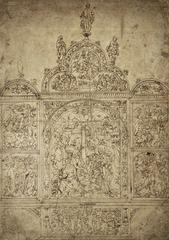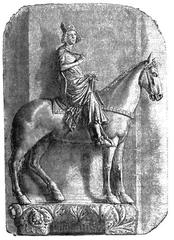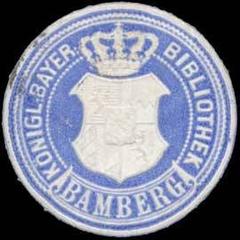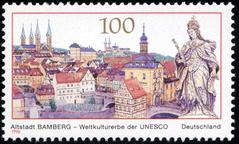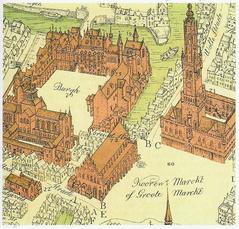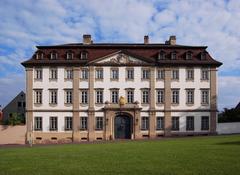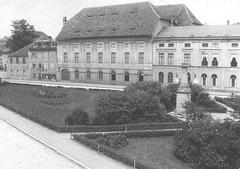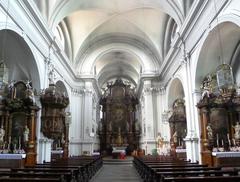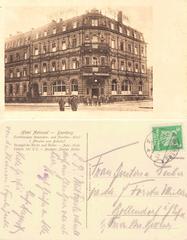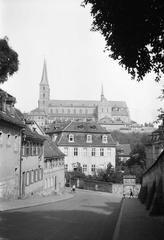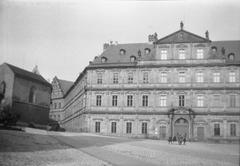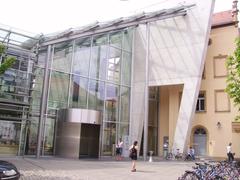Marter Bamberg, Germany: Visiting Hours, Tickets, and Historical Sites Guide
Date: 14/06/2025
Introduction: Discovering Bamberg’s Martern
Bamberg, a UNESCO World Heritage city in Bavaria, Germany, is celebrated for its well-preserved medieval architecture, picturesque streets, and vibrant Catholic traditions. Among its many treasures, the Martern (singular: Marter)—slender stone pillars or wayside shrines—stand as enduring symbols of faith, artistry, and communal memory. These monuments, often decorated with sacred imagery or topped by crosses, are woven into the fabric of Bamberg’s urban and rural landscapes, serving as both devotional markers and historical witnesses.
This guide offers a comprehensive exploration of Bamberg’s Martern, covering their history, architectural features, cultural significance, and practical tips for visitors. Whether you are a history enthusiast, a spiritual pilgrim, or a curious traveler, understanding the story and role of Martern will enrich your experience of Bamberg’s unique heritage.
(UNESCO World Heritage, Bamberg Tourism Office)
Table of Contents
- What is a Marter?
- Historical Background
- Artistic and Architectural Features
- Religious and Cultural Significance
- Notable Martern in Bamberg
- Martern in the Urban Landscape
- Visiting Hours and Tickets
- Accessibility and Travel Tips
- Guided Tours and Resources
- Nearby Attractions & Suggested Itineraries
- Local Events and Festivals
- Accommodation and Dining
- FAQ
- Visual and Interactive Resources
- Conclusion & Call to Action
- Sources
What is a Marter?
A “Marter” (plural: Martern or Martersäule) is a religious monument typical of the Franconian and Bavarian regions. These are usually stone pillars, sometimes topped with a cross or a small shrine, and often adorned with reliefs or religious figures. Erected at crossroads, parish boundaries, or along pilgrimage routes, Martern served as waymarkers, devotional sites, and symbols of faith. The term “Marter” originates from the German word for “martyr” or “passion,” reflecting their deep roots in Christian tradition.
Historical Background
The tradition of Martern in Bamberg dates from the late Middle Ages (14th century) through the Baroque period (18th century), paralleling the growth of Bamberg as a significant religious and cultural center. The establishment of the Bamberg diocese by Emperor Henry II in 1007 marked a turning point, spurring the construction of numerous religious monuments. During the Counter-Reformation, the erection of Martern intensified as Catholic identity was reinforced against Protestant influences.
Patrons ranged from noble families and religious fraternities to local guilds and parish communities. Inscriptions often record donors and dedications, offering insights into Bamberg’s social and religious history.
(Bamberg Tourism Office, nomads-travel-guide.com)
Artistic and Architectural Features
Bamberg’s Martern are typically constructed from local sandstone or limestone and stand 2–4 meters tall. They feature:
- Reliefs and Carvings: Scenes from the Passion of Christ, saints, or the Arma Christi (instruments of Christ’s suffering).
- Shrine Niches or Crosses: Some are topped with roofed shrines (Bildstock) containing painted or sculpted figures; others with simple or ornate crosses.
- Inscriptions: Donor names, dates, and religious dedications in Latin or early modern German.
- Styles: Ranging from late Gothic to Baroque, reflecting the artistry of local stonemasons and the prevailing tastes of their eras.
Religious and Cultural Significance
Martern are integral to Bamberg’s Catholic heritage. They have served as:
- Devotional Sites: Focal points for prayer, especially during processions, pilgrimages, and feast days.
- Community Markers: Commemorating historical events (plagues, wars), marking boundaries, or honoring patrons.
- Artistic Expressions: Showcasing the skill of local artisans and reflecting the city’s religious ethos.
During religious festivals like Corpus Christi, Martern are decorated with flowers and candles, underscoring their ongoing role in Bamberg’s communal life.
Notable Martern in Bamberg
- Domplatz Marter: Near Bamberg Cathedral, this shrine features a finely carved Crucifixion scene and is often adorned with offerings during religious events.
(Explorial) - Stephansberg Marter: Close to St. Stephen’s Church, this Baroque Marter honors the church’s patron and features ornate reliefs.
- Kreuzmarter at Altenburg: On the path to Altenburg Castle, this cross-shaped Marter is a traditional pilgrimage stop.
- Jakobsberg Marter: Associated with the Camino de Santiago route, it marks Bamberg’s historical role as a pilgrimage center.
Martern in the Urban Landscape
Bamberg’s Martern are strategically positioned at intersections, parish boundaries, bridges, and along major thoroughfares. They visually connect sacred spaces like the Cathedral, churches, and abbeys with the daily life of the city, reinforcing Bamberg’s reputation as the “Franconian Rome.”
(OVPM)
Visiting Hours and Tickets
- Hours: Martern are outdoor monuments accessible year-round, 24 hours a day.
- Tickets: No tickets are required to visit Martern themselves; they are freely accessible in public spaces.
- Nearby Attractions: Some museums and churches (e.g., Bamberg Cathedral, Altenburg Castle) may have specific hours and may require tickets for entry.
Accessibility and Travel Tips
- Getting There: Bamberg is well-connected by train (frequent service from Nuremberg and other cities) and is best explored on foot. Local buses (lines 901, 910, 912, 918, 989) stop near the World Heritage Visitor Centre and many Marter sites.
- Walking Routes: The city’s compact layout makes it easy to combine Marter visits with other attractions. Some shrines in rural or hilly areas may require short hikes.
- Mobility: Most urban Martern are on paved or cobblestone streets and are generally accessible; however, some sites may be challenging for wheelchair users. Check with the Tourist Information Office for accessible routes.
- Best Times: Spring and early autumn offer mild weather and fewer crowds; religious festivals provide atmospheric visits.
Guided Tours and Resources
- Guided Tours: Specialized religious heritage tours include Martern and can be booked in advance. The Bamberg Tourist Information Center offers brochures and digital maps.
- Self-Guided Options: Walking tour maps and informational plaques (often in German and English) are available at many shrines.
- Virtual Tours: Explore interactive maps and online photo galleries via the World Heritage Visitor Centre.
Nearby Attractions & Suggested Itineraries
Pair your Marter exploration with other Bamberg highlights:
- Bamberg Cathedral: A masterpiece of Romanesque architecture.
- Old Town Hall (Altes Rathaus): Unique island location and painted façade.
- Michaelsberg Abbey: Former Benedictine monastery with panoramic city views.
- Little Venice (Klein Venedig): Picturesque riverside quarter.
- Grüner Markt: Historic market square for local specialties.
(The Tourist Checklist, Europe Up Close, Explorial)
Local Events and Festivals
Martern play central roles during Catholic processions, especially Corpus Christi, when they are adorned with flowers and candles. For event schedules, check the Bamberg events calendar.
Accommodation and Dining
Stay in the old town for easy access to Marter shrines and other sites. Options include:
- Hotel Alt Bamberg: Budget-friendly, historic setting.
- Hotel Nepomuk: Boutique hotel with riverside views.
- Welcome Hotel Residenzschloss Bamberg: Luxury accommodation in a former palace.
Enjoy Franconian cuisine and local beer culture, especially Bamberg’s famous smoked beer (Rauchbier).
(Time Travel Turtle, Europe Up Close)
Frequently Asked Questions (FAQ)
Q: What are the visiting hours for Marter shrines in Bamberg?
A: Marter shrines are outdoor monuments accessible 24/7.
Q: Are tickets required to visit Marter shrines?
A: No, these shrines are free to visit. Tickets may be needed for nearby museums or churches.
Q: Are Marter shrines wheelchair accessible?
A: Most urban shrines are accessible, but some may be on uneven surfaces. Check with the Tourist Information Office for accessible routes.
Q: Is photography allowed?
A: Yes, photography is permitted. Please be respectful, especially during prayer or religious events.
Q: Can I join a guided tour focusing on Martern?
A: Yes, several operators and the Tourist Office offer themed tours.
Visual and Interactive Resources
- Images: Capture photos of Martern during early morning or late afternoon for the best light. Always use respectful composition—do not disturb offerings or climb on monuments.
- Accessibility: Use interactive maps and virtual tours from the World Heritage Visitor Centre to plan your visit.
Conclusion & Call to Action
Exploring Bamberg’s Martern offers a unique portal into the city’s spiritual and artistic legacy. Freely accessible and steeped in centuries of tradition, these shrines enrich any visit to Bamberg, whether as contemplative stops on a walking tour or as focal points during religious festivals. Enhance your experience by using interactive maps and guided tours, and combine your Marter visits with Bamberg’s other celebrated landmarks. For further resources, updates, and travel tips, download the Audiala app and follow our channels for the latest on Bamberg’s cultural heritage.
Sources
- Exploring Martern in Bamberg: History, Visitor Tips, and Cultural Significance (UNESCO World Heritage)
- Exploring Bamberg Marters: Visiting Hours, Tickets, and the Historical Significance of Bamberg’s Religious Monuments (Bamberg Tourism Office)
- Visiting Marters in Bamberg: History, Locations, and Visitor Guide (nomads-travel-guide.com)
- Marter in Bamberg: Visiting Hours, Tickets, and Historical Sites Guide (Bamberg Info)
- Additional references: Explorial, Bamberg.info, Germany Footsteps, Bamberg.info

